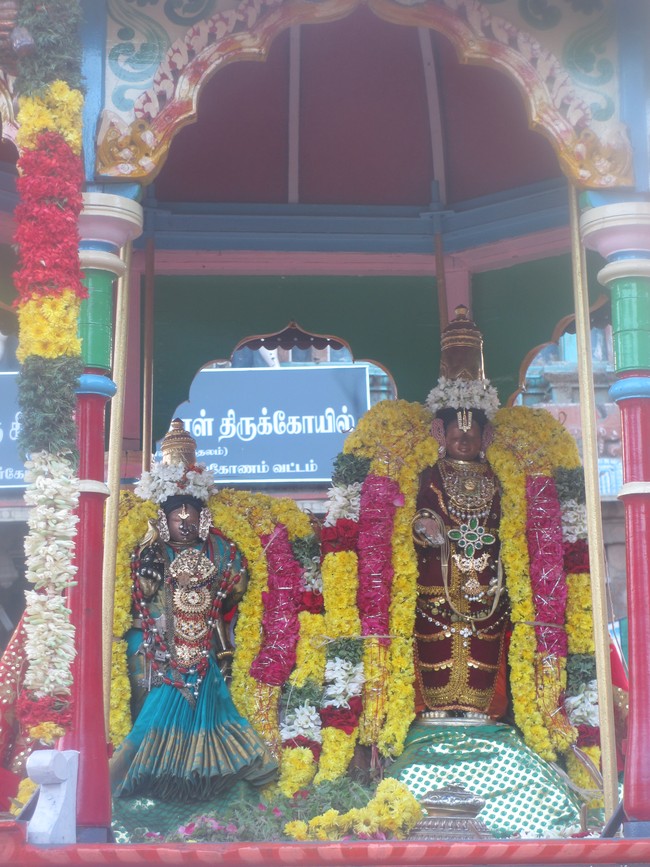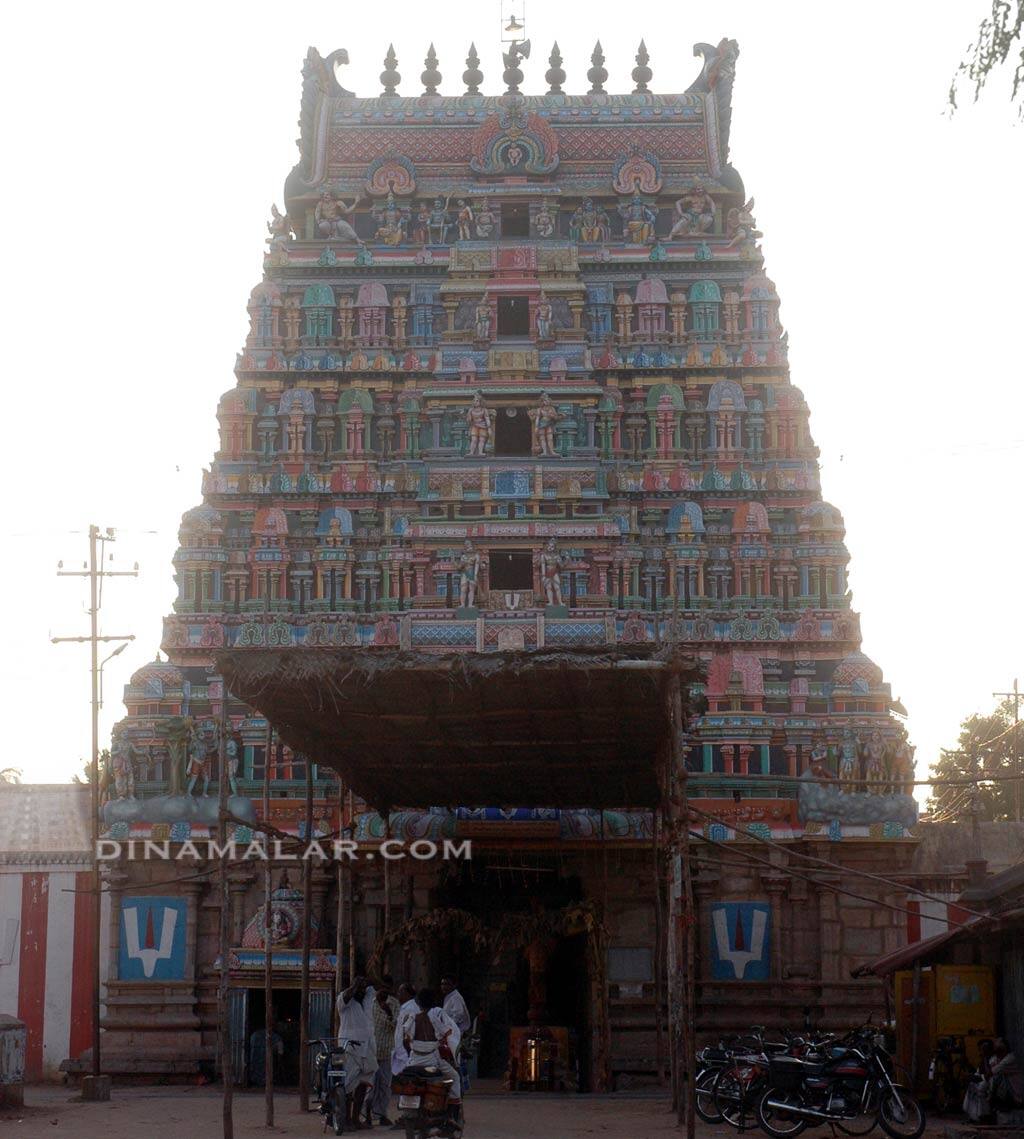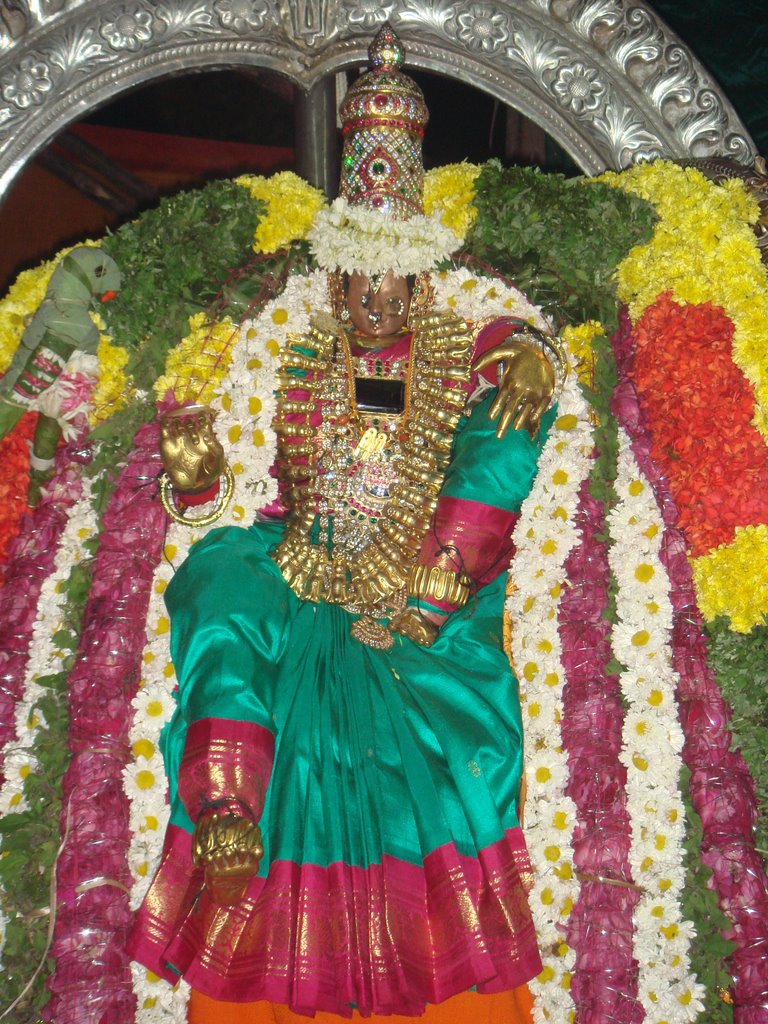GITA 7.10

GARUDA SEVAI.
We are in Nachiarkoil, one of the 40 Chola region Divya Desams. The Lord is called Sri Naraiyurninra Nambi and Sri Srinivasan. He graces the devotees along with Sri Vanjulavalli Thayar. The river Kaveri, flows through forests, where elephants and lions fight each other. So the river carries with it, broken tusks of elephants and teeth and nails of lions. All these are brought and en route get deposited in this Kshetram. So says Thirumangai Alwar. Also are deposited pearls, gold, sandal wood and other precious trees. This shows the prosperity of the place. Today's [20th March 2008] lecture is just at the entrance of the last landing place in the stairs of the temple. |
| Lecturer at the entrance to the worshiping place |
As mentioned earlier, Sri Vanjulavalli Thayar is at the centre and She alone graces along with the Lord. To Her left are Sri Srinivasan, Sri Aniruddhan, Sri Pradyumnan and Sri Purushottaman. On Her right are Sri Sankarshanan and Sri Brahma. Here it is believed that Sri Brahma does the pooja and so it is customary for the Archakas, to take permission of Sri Brahma before starting pooja. The idols are very large and are made of salagrama. The Lord, thus, graces in His five forms. Utsavar is Sri Srinivasan or Sri Naraiyurninra Nambi. He is also gracing with Sri Vanjulavalli Thayar, in a wedding pose.
 |
| Sri Vanjulavalli Thayar and Sri Naraiyurninra Nambi |
To marry Sri Thayar, the Lord came from Vaikuntam, riding on His vahanam Garuda. It is the belief here that prayer, for marriage of the near and dear ones, to the Lord and Garuda, will be blessed. Thursdays are very important here [the recording of the lecture was on a Thursday and the telecasting also was today, being Thursday!!]. Thirumangai Alwar narrates an episode in the pasurams on this Kshetram. There lived here, a male bee, Alavan and a female bee, Nalli, which was in the family way. Alavan wanted to fulfill the desires of Nalli, which wanted honey. Alavan wanted to please its spouse and so went in search of honey. It was evening and it started gathering honey from a lotus flower. Before it could finish, dusk set in and so the lotus flower closed its petals and Alavan was trapped inside. It could come out only next morning when Sun rose. Hurriedly, Alavan got back to Nalli with the gathered honey. Since it was inside the flower all night, it was smeared with the yellow pollens. Seeing Alavan with yellow pollens on the body, Nalli thought Alavan was with another female last night and so refused to let Alavan inside the hive! Alwar narrates this to describe the wealth of the place. When this pasuram was explained by Swami Parasara Bhattar, his disciple Swami Nanjeer, requested to clarify a point. He felt that the wife Bee appeared to be too cruel to drive the male bee Alavan, without even enquiring and summarily shutting the door. For this, Swami Bhattar replied that it was because of the peculiarity of the place. That is, this Kshetram being dominated by Sri Thayar, the law is one sided and females have the upper hand!
We also with the support of Sri Nambikkai Nachiyar, confidently approach the Lord and He will have to listen to Her recommendation!! The lesson we derive from this Kshetram is, for a happy family, only one wife and one husband are to be strictly followed. We will now see the sloka 8. From 8th sloka to 11th sloka, four slokas, convey a message. He is going to tell that the qualities which are attributed to various objects and persons, are all His. Earlier He told,
Kaunteya = Son of Kunthi, [understand], aham = I [Sri Krishna] am, apsu = in water, raso = taste, sasi = in moon, suryayo = and in the Sun, prabhasmi = [am] light, sarva vedesu = in all Vedas, pranava = Pranavam [AUM], khe = in sky or space, shabda = sound, nrusu = in human beings, paurusam = man power. So Sri Krishna is the taste in water, light in the Sun and Moon, Pranavam in Vedas, sound in space and Male power among all human kind. Thus all items we see and seek them for their special qualities, are all He or His qualities only. So we have to approach Him only. Every item is mentioned and their special qualities which make us to seek them and Sri Krishna tells all are He only.
- All Achits are His property
- All Chits [Atman] are His property
- All created cause and effects, are all His property
- None is equal or above Him in any of His qualities
- He is the Creator and, at the great deluge, all merge in Him
- All things perceived in the Universe are supported by Him, like a thread supporting pearls and studs in a necklace.
raso ’ham apsu kaunteya
prabhasmi sasi-suryayoh
pranavah sarva-vedesu
shabdah khe paurusam nrsu
prabhasmi sasi-suryayoh
pranavah sarva-vedesu
shabdah khe paurusam nrsu
O son of Kuntī [Arjuna], I am the taste of water, the light of the sun and the moon, the syllable om in the Vedic mantras; I am the sound in ether and ability in man.
"O son of Kunti, I am the taste of water, the light of the sun and the moon, the syllable om in the Vedic mantras; I am the sound in ether and ability of man in all humans."Kaunteya = Son of Kunthi, [understand], aham = I [Sri Krishna] am, apsu = in water, raso = taste, sasi = in moon, suryayo = and in the Sun, prabhasmi = [am] light, sarva vedesu = in all Vedas, pranava = Pranavam [AUM], khe = in sky or space, shabda = sound, nrusu = in human beings, paurusam = man power. So Sri Krishna is the taste in water, light in the Sun and Moon, Pranavam in Vedas, sound in space and Male power among all human kind. Thus all items we see and seek them for their special qualities, are all He or His qualities only. So we have to approach Him only. Every item is mentioned and their special qualities which make us to seek them and Sri Krishna tells all are He only.
(continued)














